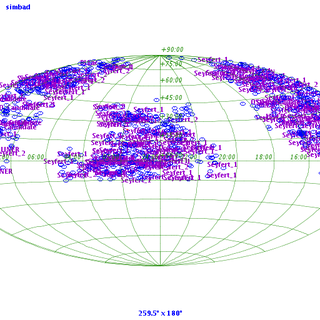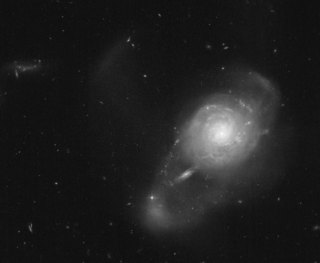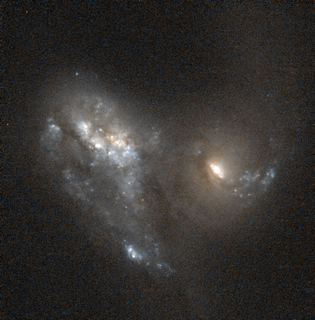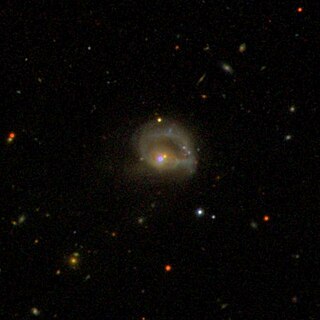 W
WThe Markarian galaxies are a class of galaxies that have nuclei with excessive amounts of ultraviolet emissions compared with other galaxies. Benjamin Markarian drew attention to these types of galaxies starting in 1963. The nuclei of the galaxies had a blue colour, associated to stars in the classes from O to A. This blue core did not match the rest of the galaxy. The spectrum in detail tends to show a continuum that Markarian concluded was produced non-thermally. Most of these have emission lines and are characterized by highly energetic activity. Markarian Catalogue entries are of the form "Markarian ####", and can frequently use the abbreviations Mrk, Mkr, Mkn; and rarely Ma, Mk, Mark.
 W
WNGC 262 is a huge spiral galaxy in the cluster LGG 14. It is a Seyfert 2 spiral galaxy located 287 million light years away in the constellation Andromeda. It was discovered on September 17, 1885 by Lewis A. Swift.
 W
WNGC 7679 is a lenticular galaxy with a peculiar morphology in the constellation Pisces. It is located at a distance of circa 200 million light years from Earth, which, given its apparent dimensions, means that NGC 7679 is about 60,000 light years across. It was discovered by Heinrich d'Arrest on September 23, 1864. The total infrared luminosity is 1011.05 L☉, and thus it is categorised as a luminous infrared galaxy. NGC 7679 is both a starburst galaxy and a Seyfert galaxy.
 W
WNGC 7592 is an interacting galaxy system located 300 million light years away in the constellation Aquarius. It was discovered by William Herschel on September 20, 1784. The total infrared luminosity is 1011.33 L☉, and thus it is categorised as a luminous infrared galaxy. One of the galaxies hosts a type 2 Seyfert nucleus.
 W
WMarkarian 231 is a Type-1 Seyfert galaxy that was discovered in 1969 as part of a search of galaxies with strong ultraviolet radiation. It contains the nearest known quasar. Markarian 231 is located about 581 million light years away from Earth.
 W
WNGC 5256 is a galaxy that contains two disc galaxies, that are colliding into each other. It is located in the constellation Ursa Major, and was discovered by William Herschel on 12 May 1787. The two nuclei of the galaxies are separated by about 13046.3 light years. NGC 5256 is located at about 350 million light years away from the earth.
 W
WMarkarian 421 is a blazar located in the constellation Ursa Major. The object is an active galaxy and a BL Lacertae object, and is a strong source of gamma rays. It is about 397 million light-years to 434 million light-years (133Mpc) from the Earth. It is one of the closest blazars to Earth, making it one of the brightest quasars in the night sky. It is suspected to have a supermassive black hole (SMBH) at its center due to its active nature. An early-type high inclination spiral galaxy is located 14 arc-seconds northeast of Markarian 421.
 W
WMarkarian 501 is a galaxy with a spectrum extending to the highest energy gamma rays. It is a blazar or BL Lac object, which is an active galactic nucleus with a jet that is shooting towards the Earth.
 W
WNGC 7674 is a spiral galaxy located in the constellation Pegasus. It is located at a distance of circa 350 million light years from Earth, which, given its apparent dimensions, means that NGC 7674 is about 125,000 light years across. It was discovered by John Herschel on August 16, 1830.
 W
WNGC 1614 is the New General Catalogue identifier for a spiral galaxy in the equatorial constellation of Eridanus. It was discovered on December 29, 1885 by American astronomer Lewis Swift, who described it in a shorthand notation as: pretty faint, small, round, a little brighter middle. The nebula was then catalogued by Danish-Irish astronomer J. L. E. Drayer in 1888. When direct photography became available, it was noted that this galaxy displayed some conspicuous peculiarities. American astronomer Halton Arp included it in his 1966 Atlas of Peculiar Galaxies. In 1971, Swiss astronomer Fritz Zwicky described it as a "blue post-eruptive galaxy, compact patchy core, spiral plumes, long blue jet SSW".
 W
WNGC 2273 is a barred spiral galaxy located in the constellation Lynx. It is located at a distance of circa 95 million light years from Earth, which, given its apparent dimensions, means that NGC 2273 is about 100,000 light years across. It was discovered by Nils Dunér on September 15, 1867.
 W
WNGC 931 is a spiral galaxy located in the constellation Triangulum. It is located at a distance of circa 200 million light years from Earth, which, given its apparent dimensions, means that NGC 931 is about 200,000 light years across. It was discovered by Heinrich d'Arrest on September 26, 1865. It is classified as a Seyfert galaxy.
 W
WNGC 985 is a ring galaxy in the constellation of Cetus. It is located about 550 million light years away from Earth, which means, given its apparent dimensions, that NGC 985 is approximately 160,000 light years across. It was discovered by Francis Leavenworth in 1886. It is a type 1 Seyfert galaxy.
 W
WNGC 1142 is a distorted spiral galaxy in the constellation of Cetus. It is located about 370 million light years away from Earth, which means, given its apparent dimensions, that NGC 1142 is approximately 170,000 light years across. It is a type 2 Seyfert galaxy. It interacts with the elliptical galaxy NGC 1141.
 W
WNGC 5548 is a Type I Seyfert galaxy with a bright, active nucleus. This activity is caused by matter flowing onto a 65 million solar mass (M☉) supermassive black hole at the core. Morphologically, this is an unbarred lenticular galaxy with tightly-wound spiral arms, while shell and tidal tail features suggest that it has undergone a cosmologically-recent merger or interaction event. NGC 5548 is approximately 245 million light years away and appears in the constellation Boötes. The apparent visual magnitude of NGC 5548 is approximately 13.3 in the V band.
 W
WNGC 7469 is an intermediate spiral galaxy in the constellation of Pegasus. NGC 7469 is located about 200 million light years away from Earth, which means, given its apparent dimensions, that NGC 7469 is approximately 90,000 light years across. It was discovered by William Herschel on November 12, 1784.